The Origin of Life
602-609
It is "dangerous" to extrapolate a scientific proposition on the basis of only 1 data point! But - when we consider life in the universe that is all we have to work from. Despite this, it is reasonable to at least speculate on the possibility of life elsewhere in the universe and to better understand how the conditions on the early Earth were conducive to the formation of life.
Life of Earth The earliest known fossils that show unequivocal evidence for life are from aquatic organisms dating back more than 3.4 billion years. These fossils are found in stromalites which are sedimentary accretions that contain remains of blue-green algae. Figure 20.5 shows a stromalite layer in rock near Helen Lake in Banff National Park. This layer is from the precambrian period. |
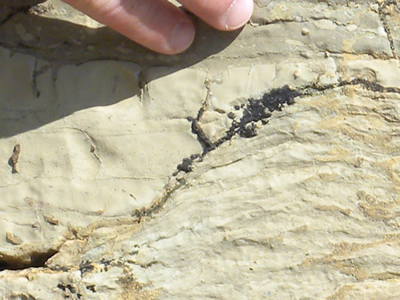 |
| Figure 20.5 Precambrian Stromalite layer from Helen Lake area- Banff National Park (credit Mark A. Wilson , image in public domain) |
What was Earth's primordial atmosphere like? It is quite likely that volcanoes produced significant quantities of carbon dioxide, water vapour, sulfates and nitrogen compounds. UV radiation from the sun would also play a role and help in the formation of methane and ammonia. In the early 1950s Stanley Miller and Harold Urey preformed a classic experiment. In the Urey-Miller experiment a flask of gas was prepared to simulate the primordial atmosphere. A high energy spark was passed through this gas and the entire experiment was allowed to run for 1 week. A heated flash of water provided a continuous cycle of gas through the system and a condensing column allowed water vapour and other compounds to re-condense into the water solution. Figure 20.6 provide a schematic diagram of this.
Urey and Miller discovered that the water solution became enriched with organic molecules including several amino acids.
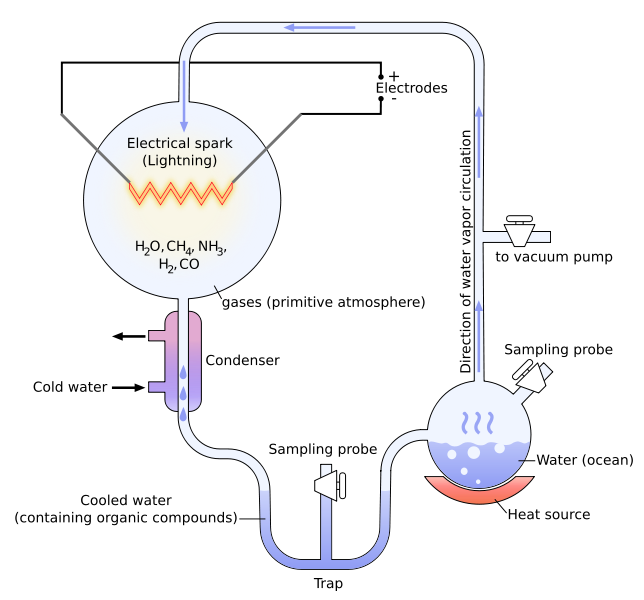 |
| Figure 20.5 Schematic diagram of the Urey-Miller Experiment setup (credit YassineMrabet, GNU copyright licensing) |
Example 20.3 Discuss the significance of the Urey-Miller Experiment. Did they produce "life in a test tube"?
Solution: The Urey-Miller Experiment demonstrates that complex, carbon molecules form naturally from the kinds of compounds that we expect were present in Earth's primordial atmosphere. These organic molecules are essential fro life as we know it and the experiment demonstrates the plausibility that life arose through natural means. However, they did not "produce life" and the step from raw materials (organic molecules including amino acids) to life is an enormous one, some of the details of which we barely understand and some details still completely unknown.
The Urey-Miller experiment is an important first step in our understanding of how life may have originated on Earth. It likely arose in an oxygen poor atmosphere and started in the oceans. The concept of "primordial soup" is an extrapolation on the results of the Urey-Miller experiment and reflects the hypothesis that life evolved in the oceans from the simplest organic molecules. Stromalites help bolster this idea.
What separates a complex organic molecule from a "living molecule?" One characteristic that we think describes a "living molecule" is the ability of the molecule to reproduce itself. Eventually, it is believed, molecules developed that had that ability. Through time more complex molecules and groups of molecules assembled as crude one-celled organisms.
The Concept of Geologic Time
Until about 600 million years ago life on Earth consisted of one-celled organisms (bacteria). Geologists classify this as the precambrian period or era. The nature of life on Earth changed dramatically about 540 million years ago when multi-cellular life forms emerged in what is now called the cambrian explosion. In a relatively short (in geologic terms) time span the diversity and complexity of life on Earth blossomed. This marked the start of the cambrian period. Evidence for this is provided wonderfully by fossils found in the Burgess Shale - a small region located in Yoho National Park in British Columbia. The Burgess Shale is considered the richest source cambrian era fossils and was named a UNESCO World Heritage Site in 1981. Access to the shale is now restricted and accessible only for scientific or educational purposes. The division of the past into periods or eras is called the Geologic Time Scale and this is shown in Figure 20.6. We are currently living in the Tertiary Period - prior to that was the Cretaceous Period. In a previous chapter you learned about the K-T or Cretaceous-Tertiary boundary. This boundary in geologic time marks the end of the period of dinosaurs and the emergence of mammals.
|
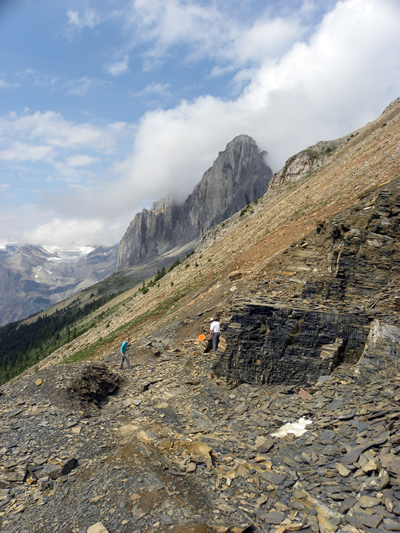 |
| Figure 20.6 The Burgess Shale in Yoho National Park. (credit Mark A. Wilson - image in public domain) |
Example 20.4 The following analogy illustrating how recently human civilization appeared on Earth is often used. Imagine that the Earth came into existence on January 1. Then humankind appears at the end of the year at 11:59 pm on New Year's Eve! Does this analogy make sense?
Solution: Human kind made the transition from hunter-gatherer clans to communities no more than 10 000 years ago. This represents only the following ![]() or 2 millionths of the history of the planet!
or 2 millionths of the history of the planet!
In 1 year there are 365.25 X 1440 minutes = 5.3 X 105 minutes, so 1 minute out of an entire year is ![]()
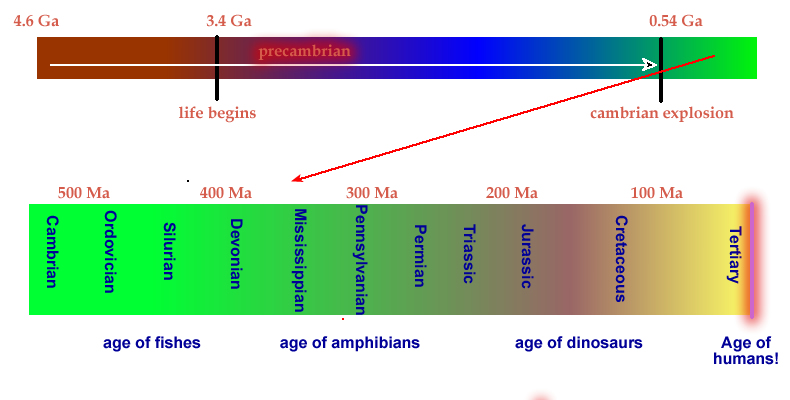 |
| Figure 20.7 Geologic Timeline showing major eras or periods |
Life in the Solar System
Are there regions in the solar system other than Earth hospitable to simple (perhaps unicellular) forms of life? Although Mars may be considered the "best bet" it need not be the only solar system object to be considered. The Jovian moon Europa contains large amounts of liquid water beneath its surface. The tidal stretching caused by its interaction with Jupiter provides the moon with a source of heat and spectroscopy tells us that the outer moons are rich in simple organic molecules.
| Whether it's Mars, Europa or some other object one common theme is that liquid water plays an important role in the formation or propagation of life in the form we understand it. Mars shows clear evidence of having had much larger quantities of liquid water in its distant past. The search for signs of life on Mars remains an open and actively pursued question. One recent example of possible evidence for life on Mars came from the meteorite sample ALH84001 shown in Figure 20.8. This is a meteorite discovered in Antarctica in 1984 and believed to have originated on Mars. The image shown is an electron micrograph and some scientists claim that the curious tube-like structures, which are about 1/500th the thickness of a human hair , are fossils of ancient bacteria. While this is an intriguing hypothesis other explanations not involving life have been put forward to explain these structures. | 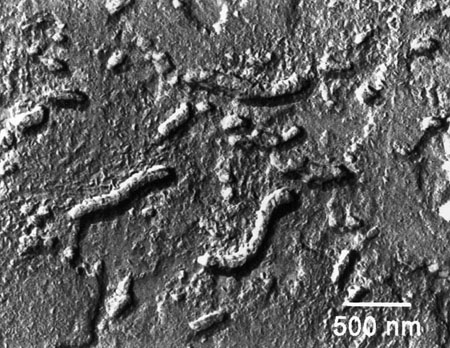 |
| Figure 20.8 Electron micrograph of meteorite ALH84001 showing possible fossilized remains of ancient bacteria on Mars. (image courtesy NASA) |
Life in Other Planetary Systems
Does life exist on exoplanets? We cannot answer this question at the present time but we can speculate about some broad sets on conditions that would seem to be necessary for the possibility of life as we know it. These conditions include:
| Parent Star Spectral Class: We know that life took a very long time to evolve on Earth - roughly 3 billion years from single cell bacteria to even the most primitive of multi-cellular organisms. This would rule out planets around massive stars because they evolve much too quickly. It is most likely that if life does exist in other solar systems they will have a G-type of later spectral class star. |
| Planets would likely orbit a single star - planets around a multiple star system would likely have precarious orbits and it is not clear if planets would even form in a multiple star system. |
| Planets should be in the "just right" or habitable zone. This means that the distance from the parent star provides a temperature that would permit the 3 phases of water to coexist. There are, of course, exceptions to this even in our own solar system. Europa lies far outside the habitable zone but liquid water exists because of tidal heating. Also, some bacteria thrive in the scalding environs around deep ocean vents. Perhaps life is much "adaptable: than we first thought! |
Example 20.5 In the Hollywood movie Contact astronomers discovered a signal from a suspected extrasolar civilization coming the star Vega. Why - even in the movie - did they discount this as the evidence for a civilization orbiting Vega?
Solution: Vega is an A0 type star. This means it has a larger mass than the Sun (2.11Mo) and thus ages must faster than our star. Vega will only be on the main sequence for about 1.5 billion years and hence probably not enough time for life to form and evolve if we use Earth as an example.
Practice
-
Why would the presence of an oxygen rich atmosphere around an exoplanet be a significant find? Would it prove that life exists elsewhere in the universe?
- GIve examples of two of the oldest known life forms found as fossilized remains on Earth.
- What was the "Cambrian explosion"?
- When did the "age of dinosaurs" end? Why?
- Discuss the distinction between chemical evolution and biological evolution.

The understand how life may have come into existence on Earth
Chp 26-2

organic molecules are not "alive" - the term means that they are carbon based molecules.

ALH84001 was the first meteorite discovered in 1984 at the Alan Hills site in Antarctica - hence its name ALH84001. The meteorite was ejected from Mars during a massive impact event about 16 million years ago. Dating methods also suggest it landed on Earth roughly 13 thousand years ago.